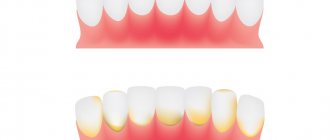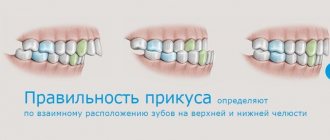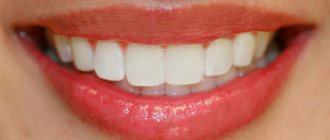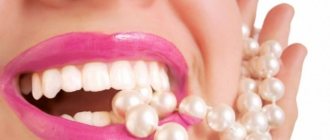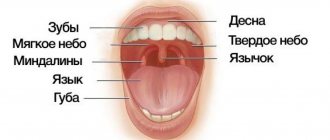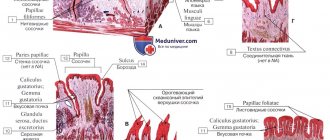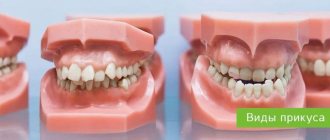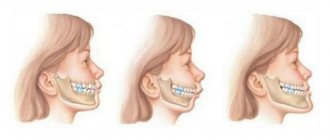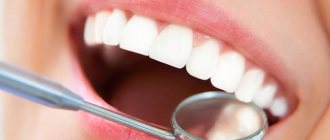The main methods of treating missing lower teeth
In the case where a tooth is completely missing (even the root is missing), restoration of the lower jaw teeth is carried out using one of the methods below:
- Installation of a fixed bridge prosthesis. The method is used when one or more teeth are destroyed or lost; the remaining healthy teeth serve as supports for the bridge structure. Fixed dentures cannot redistribute the chewing load on the jaw; therefore, when chewing, the load is not distributed evenly, but only on the supporting teeth to which the denture is attached. The fixation of fixed dentures is permanent, and it is impossible to remove such dentures yourself without the help of a dentist. The advantages of the method are aesthetic characteristics, restoration of chewing function, fast treatment time and relative low cost compared to dental implantation. Disadvantages - the need to depulp possibly healthy teeth, uneven distribution of the load, ongoing atrophy of the bone tissue of the alveolar crest in places where teeth are missing.
- Use of removable dentures. Most often they are used for long-term defects in the dentition (the absence of 3 or more teeth in a row). However, sometimes they are used in the absence of only 1-2 teeth (butterfly dentures) - if the patient does not want to undergo implantation or grind adjacent teeth for crowns. It is recommended to remove removable dentures once a day for hygienic procedures. Such dentures are less comfortable than fixed ones, because... occupy a significantly larger volume. Due to anatomical features, removable dentures for the lower teeth are smaller in size than the upper ones. Advantages: low cost, minimally invasive treatment, acceptable aesthetics. Disadvantages - does not restore chewing function, does not prevent bone tissue atrophy, the need for daily removal and periodic relining.
- Dental implantation. Implants are installed both when one or several teeth are lost in a row. Their purpose is to replace the biological root of a tooth; in prosthetics, implants are used as supports for artificial crowns: metal-ceramic or ceramic with a zirconium dioxide frame. Three main stages of implantation: installation of the implant into the bone tissue, formation of aesthetic gums, fixation of abutments on the implants and installation of crowns on the abutments. Implants can also be used in cases of complete absence of teeth in the lower jaw. The main advantage of implantation is the almost complete restoration of chewing function, and, as a result, the cessation of bone atrophy; such prosthetics also provide excellent aesthetics.
If the root of the tooth is not removed and there is a possibility of preserving it for use under a fixed prosthesis, the stump of the tooth is first restored, onto which a crown - metal-ceramic or completely ceramic - is fixed.
Classification
In orthodontic practice, various assessment criteria are used to determine which dental bite is correct and how to correct existing anomalies. The ideal situation, in which nothing needs to be corrected, is characterized by the following indications:
- Semi-elliptical shape of the upper and parabolic shape of the lower arc.
- Small - no more than a third - overlap of the vestibular surface of the mandibular elements.
- Contact of antagonists during closure and absence of obvious gaps.
Compliance on all points is quite rare, but in most cases the deviations are minimal and do not require medical intervention. Often the cause of imbalance is not congenital defects, but bad habits, some of which are formed at an early age.
Types of correct bite
In accordance with the generally accepted classification, there are four main types of occlusal relationships, characterized by the absence of problems and not having a negative effect on the jaw region.
Orthognathic
The optimal, from an aesthetic point of view, is a condition in which all elements of the dentition have an even shape, are located in the correct manner, without gaps or deviations from the midline.
Straight
A common phenomenon, the main feature of which is the lack of overlap - the cutting edges of the incisors meet along a line, which causes a specific type of smile, but is not considered as a pathology.
Biprognathic
Another type of even dentition without threes and diastemas, the distinctive feature of which is a slight deviation of the vertical growth vector of the units. With this development, the crowns are slightly tilted forward.
Progenic
In a normal state it is not accompanied by abnormal manifestations. The identifying feature is a slight frontal protrusion of the lower units.
Implantation of lower teeth is the best solution
Dental implants are artificial tooth roots, most often made of titanium (can also be ceramic or tantalum), a biocompatible metal, or its alloys. The word is made up of the Latin "im" meaning "inside" and "planta" meaning "sapling". Thus, implantology deals with replacing lost tooth roots with artificial ones through the installation of dental implants.
Implants for the lower jaw in the absence of teeth are inserted into the bone tissue, and then the dentist fixes a crown, fixed bridge or removable denture on them. Dental implants not only maintain the strength of your chewing muscles, but also strengthen your jaw bones. They help maintain facial proportions. Dental restoration with implants helps prevent the signs of aging. After implantation, patients look younger.
According to foreign statistics accumulated since the 1960s, the service life of a correctly installed implant ranges from 20 years to life. The service life depends significantly on the patient’s discipline in oral hygiene.
Which material is better and will last longer?
The material from which the prosthesis is made has the greatest impact on wearing comfort, and this is especially true for removable structures. If no errors were made during the manufacture of the structure itself, but the prosthesis still causes significant discomfort, then the problem is most likely due to the poor quality of the material. Of course, no such design can provide 100% convenience (especially at the adaptation stage), but modern materials make it possible to achieve very high performance. So, what qualities should the best materials for dentures have:
- Hypoallergenic.
Many people are allergic to dyes and acrylates. - "Friendly" to gums.
If the denture rubs the gums a lot, wearing it will be a complete torture. - Color fastness.
Immunity to staining and environmental influences. - Acceptable strength.
Despite the fact that a removable denture rarely lasts more than 5–6 years, the structure should not be overly fragile.
If we talk about specific brands of removable dentures, the best lamellar denture is considered to be Acry-Free (“Acry-Free”) made of acrylic-free plastic: it is very comfortable, does not shrink when worn, does not stain and does not cause allergies. The best nylon dentures at the moment are Quadrotti. However, they have limitations for use: to install such a prosthesis, one of the jaws must have several healthy teeth, however, like other clasp-type prostheses. As for non-removable systems, metal-free structures are increasingly being used, which look more aesthetically pleasing, do not cause allergies, but are no less durable.
Before and after installation of dentures. Works by P. A. Zotov
Features of implantation of lower chewing teeth
The chewing teeth of the lower jaw bear the highest load. Implantation of the lower teeth should be carried out after preliminary planning and modeling of future teeth, since in some cases, the artificial root will have to withstand the load, which was previously distributed over 3-4 natural tooth roots. And the chewing force is calculated to be at least 30 - 40 kg per tooth.
Another argument in favor of planning is that the diameter of the implant neck is smaller than the conventional neck diameter of the biological posterior tooth, which means that the shoulder between the crown and the implant will be larger, and any deviation of the implant axis from the direction of the application axis will lead to greater negative consequences.
Therefore, classical implantation with preliminary planning, in two stages with delayed loading, is an ideal option for restoring lower chewing teeth. That is, first an implant is installed, and then, a few months later, a permanent crown is fixed onto it.
Sometimes, before dental implantation, bone grafting is required - a surgical operation to build up bone tissue at the site where the implant is supposed to be installed. The fact is that for implantation to be effective, certain parameters of bone tissue are required - height, width and density, and if tooth extraction was traumatic or a lot of time passed between tooth loss and implantation, then most likely the bone has atrophied.
Which teeth bite is not considered correct?
The presence of deviations from the norm is at least the basis for a dental diagnosis, based on the results of which a decision is made on the need for treatment. The best option is orthodontic correction in childhood, since the dentofacial apparatus, which is in the stage of formation, is more easily amenable to the targeted influence of a special machine and takes on the desired structure without surgical intervention. The most commonly diagnosed abnormal forms have certain signs that allow us to understand whether a person’s bite is correct or not, what is going wrong, and how this deviation can affect the further development of the jaw:
- Distal - diagnosed with excessive development of the upper jaw, noticeably protruding forward and distorting facial features.
- Mesial is a reverse pathological condition in which the mandibular row protrudes, almost completely covering the incisors and canines.
- Cross - characterized by the presence of free areas between the teeth, as well as a “scissor” intersection of elements in a random order.
- Deep - significant, more than 30%, overlap of the lower section.
- Open - contact during closure is observed only between individual chewing units, while in the incisal region there are pronounced gaps, creating the impression of a constantly slightly open mouth.
Any pathological manifestation requires timely medical intervention. Not all patients know what a correct bite in a person is and what it is needed for - but this indicator affects the quality of respiratory and speech function, ensures the conditions for normal food processing and the functioning of the gastrointestinal tract. By contacting Dentika dentistry, you can undergo a comprehensive diagnosis, receive recommendations from qualified specialists and, if necessary, resort to orthodontic correction services.
Features of implantation of lower front teeth
In modern humans, the chewing load on the front teeth, due to a specific diet, is small. People rarely use their incisors to bite tough foods; in recent centuries, they have been using a knife and fork more often. Rather, healthy and beautiful teeth in the smile area emphasize its beauty and certain life values of their owner.
Therefore, the decisive factor in choosing a method of prosthetics for the lower front teeth will be the most complete imitation of the appearance of a natural tooth.
The most aesthetic result is achieved with the help of metal-free ceramic prostheses on a zirconium dioxide frame, which are most often used in the manufacture of anterior dental implants. The abutment must also be made of zirconia.
An excellent result can be achieved by using metal-ceramic crowns, but in certain lighting, this may be noticeable to others... Although this applies more to the upper front teeth.
How much do the best dentures cost?
| Construction type | Price |
| Crowns | From 12,000 rubles for metal ceramics to 40,000 for zirconium crowns |
| Veneers | 20,000 – 55,000 rubles per unit |
| Partial denture on implants | From 70,000 rubles |
| Classic bridge | On average 8,000 – 15,000 rubles |
| Complete denture on implants | 150,000 – 600,000 rubles for one jaw. Depends on the number and brand of implants implanted. |
| Butterfly prosthesis | From 4,000 rubles depending on the material |
| Plate dentures | From 20,000 rubles. 30,000 – 35,000 rubles for Quadrotti prostheses |
| Removable complete denture | On average 35,000 rubles for a full Acry Free prosthesis |
| Removable denture on mini-implants | 100,000–120,000 rubles for one jaw |
Publisher: Expert magazine about dentistry Startsmile.ru
